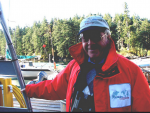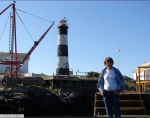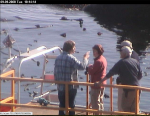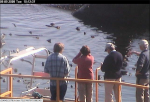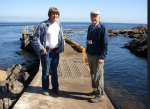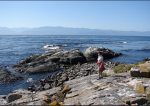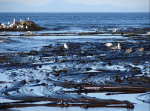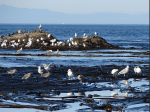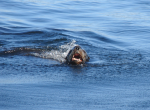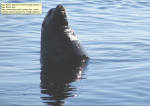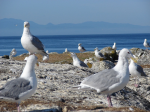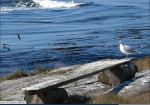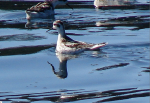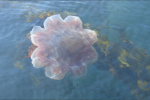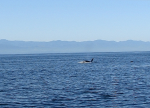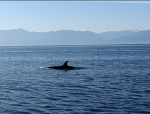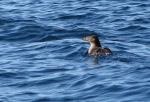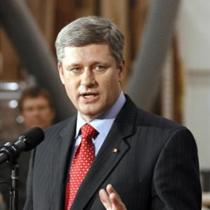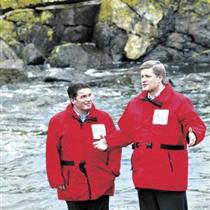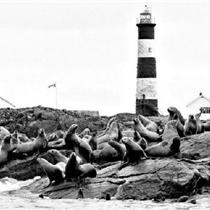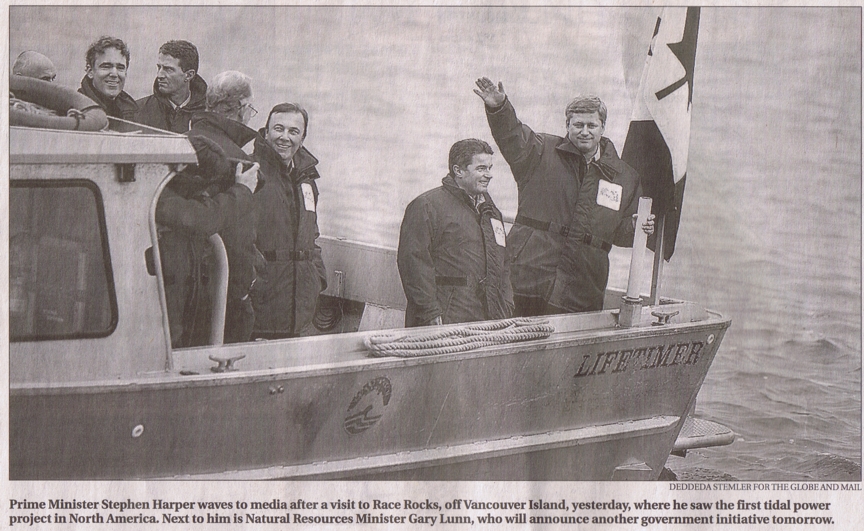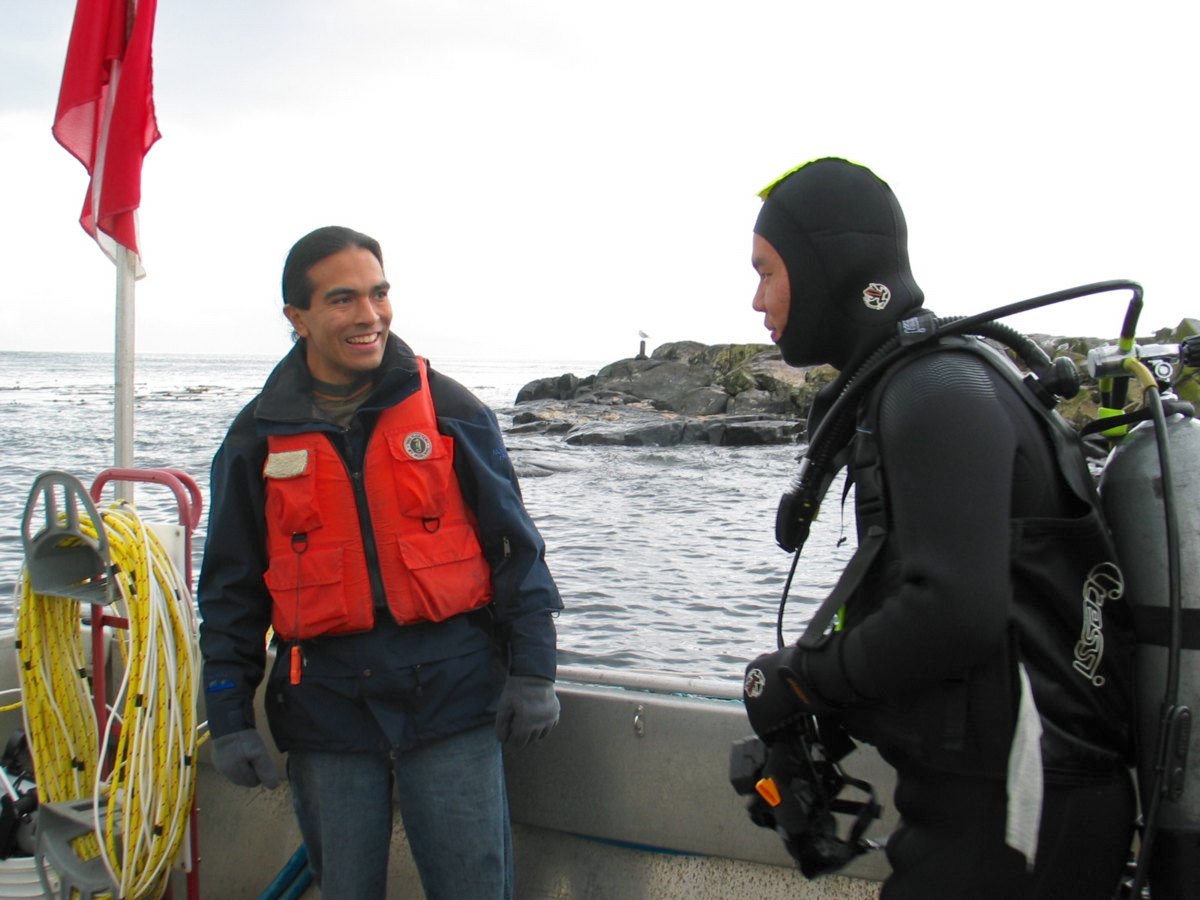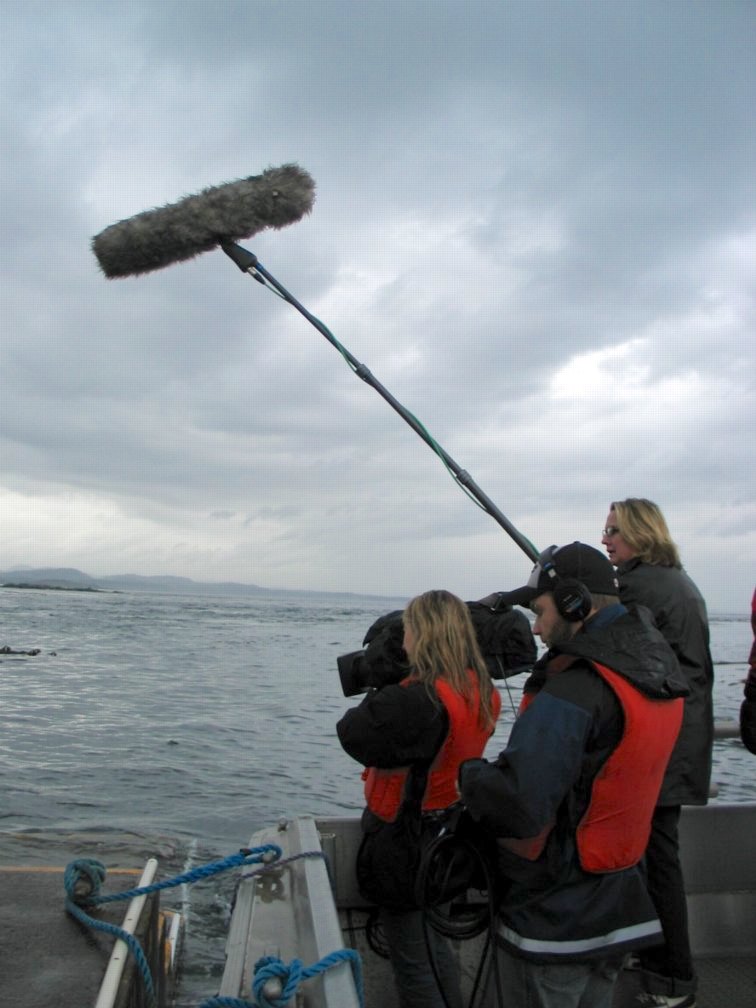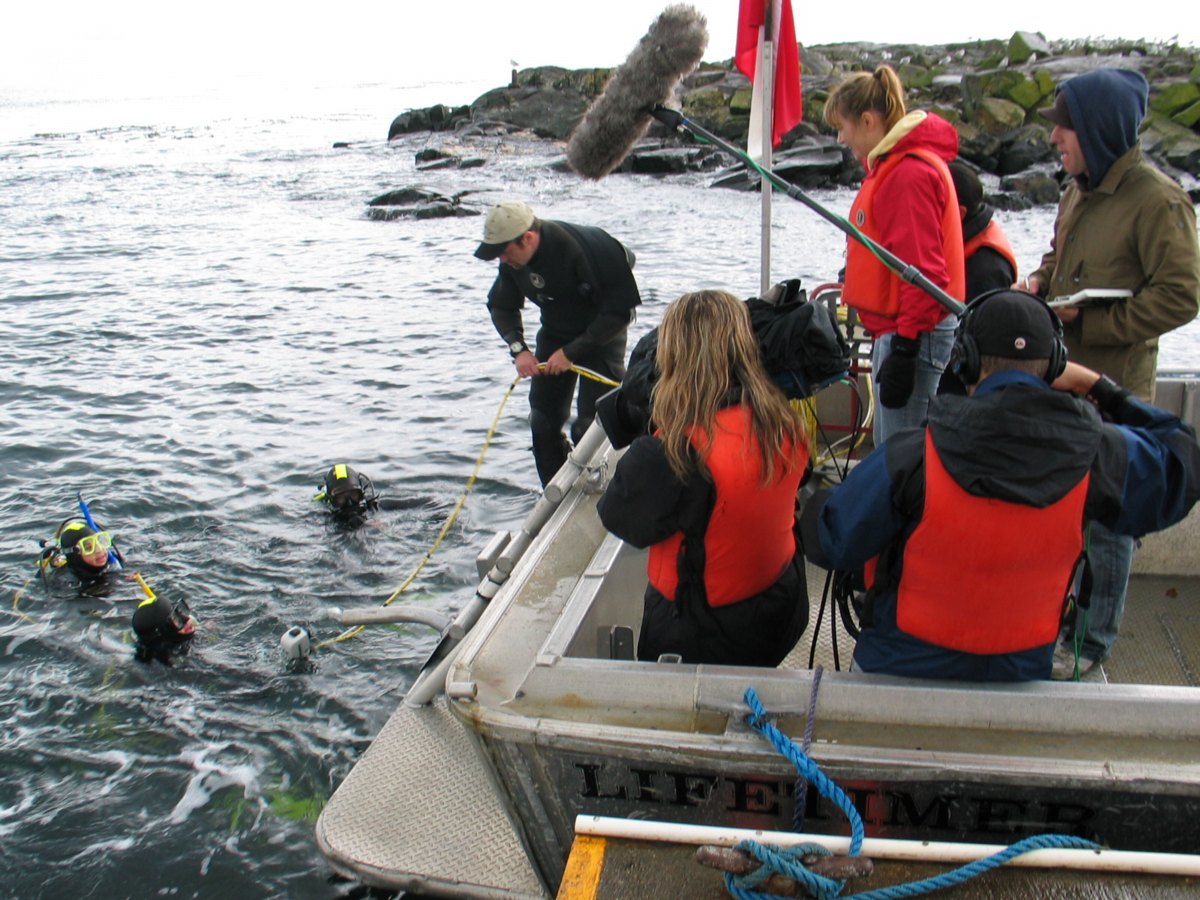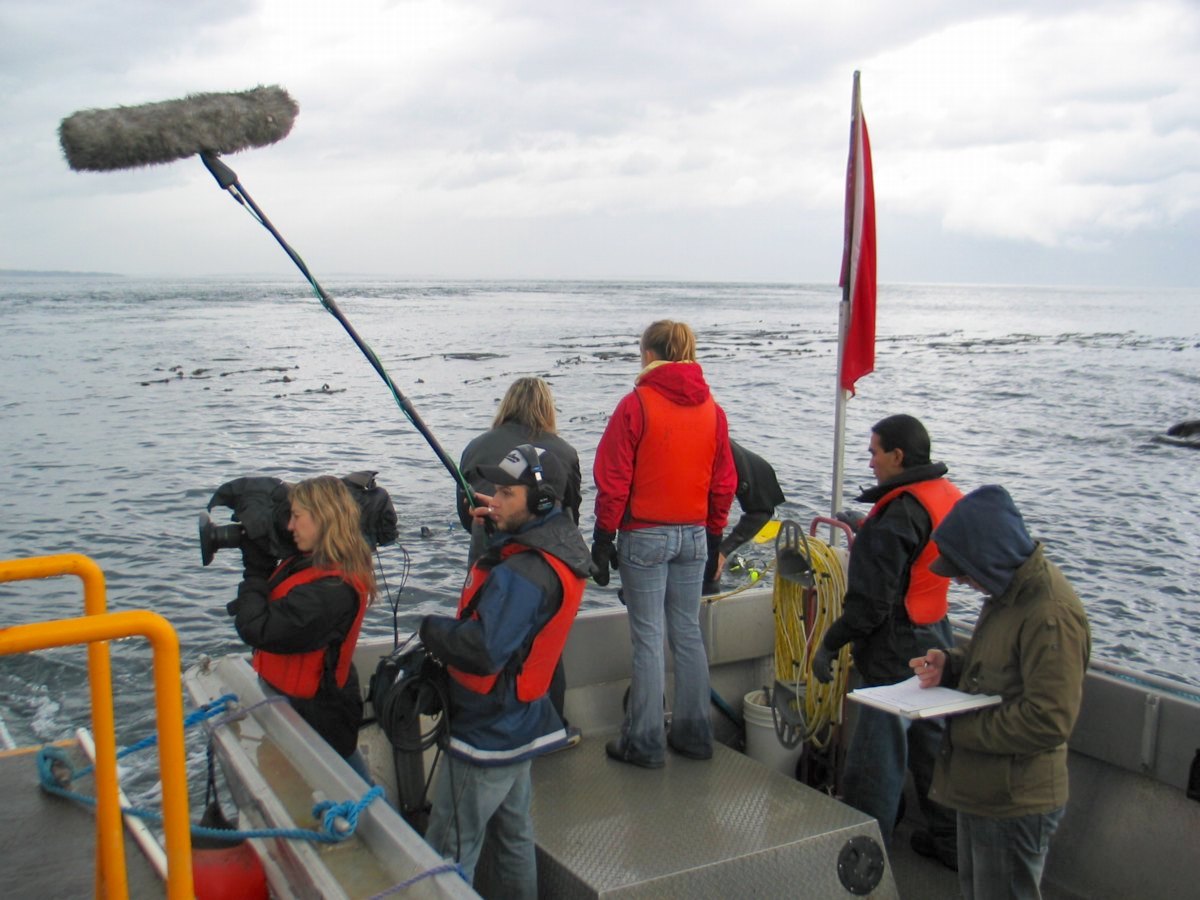Human Interaction
A school group with students from Japan and New York came for a tour of the island today.
There were 20 visitors to the island today.
Vessels in reserve:
Eco-Tour: 3
Pleasure: 1
As we officially kick off summer, I thought I’d give a bit of an update on life on the island right now. The black oystercatcher chicks have hatched in the nest up beside the jetty and down off the tank room! While outside doing some cleanup yesterday morning, I spotted at least one chick, and I suspect there may be more, as there were three eggs in total. This hatching brings some relief, as all of us were quite worried about this nest. Mother oystercatcher had not been spending as much time on her nest as she should have, what with the high traffic transiting the area. However, last week I cordoned off the area with large ropes and she settled down a lot, just in time for the hatching. I also set up camera 3 beside the nest; it can be viewed at http://www.racerocks.com/racerock/video3.htm. I apologize in advance for the moisture on the lens; we’ve had some high winds and rain over the last day and it has become a bit dirty. At this point though, I’m a bit apprehensive to get close and clean it, as it’s really only a foot away from the nest. There are at least two other nests on the island with chicks; one in the surge channel facing the southeast, and one in the channel facing the southwest. In other news, Bertha has decided to make a reappearance on the island after a few days off in the water somewhere. She is hauled up in her favourite spot behind the tank room. Her bad eye is looking worse than ever, and is dripping quite a lot of serum. #4252 is up beside the base of the lighthouse, on the side adjacent to the desalinator bunker, and seems to be enjoying the shelter of the long grasses. Misery is up around the science house somewhere. From the house this morning, I also noticed a possibly fourth, middle-aged, female elephant seal making her way up from the boat ramp (it may have been Bertha though, it’s hard to tell).
Yesterday, three harlequin ducks were spotted in the southeast surge channel, sitting contentedly on rocks. There appeared to be two males and one female. I took some pictures yesterday, but am not sure if they turned out because of the distance. Check on my Flickr site later: http://www.flickr.com/photos/adamharding/. Most seagulls have now settled down into their nests, with a few still mating. Nest numbers seem to be down from this time last year. Enjoy the solstice!
Category Archives: Island Visitors
Visitors today
Human Interaction
Josh from Maintenance at PC, several students staying the summer at the College and Christina came for a late afternoon tour of the Island. There were 5 visitors to the island today.
Transient Orca heading east
Orca: 2
Two transient orcas were spotted last evening swimming west to east through Race Passage, possibly feeding.Human Interaction
There were 3 visitors to the island today.( Ryan Murphy)
Visitors to Race Rocks
Glen Rasmussen, of the DFO Nanaimo office and a group of his counterparts from New Zealand made a trip with Garry and Chris to Race Rocks.
Pam and Dennis Visit the Ecological Reserve
‘Garry took Pam and Dennis Birley out to the Island today. Pam does the monthly photo diary from camera 5 from her home iin Leicester England .
- Pam Birley at Race Rocks 2008
- Dennis Birley
Pam took the following images when she was out on the island and on the boat. See her gallery here.
- RR from the back side of BentinckIsalnd
- Mike greets us at the docks
- Arrival at the docks from Camera 5
- Pam looking at sealions, Dennis is texting
- Mike and garry
- Pam on south shore
- Heermans gulls along with others
- back fro the hunt
- Sealion
- Glaucous-winged Gulls
- Canada geese
- Pam would like to sit on this bench
- and watch the harbour seal and gulls
- Calendula naturalized on the island
- Re-Necked Phalarope
- Cyanea in the water
- Transient Orca
- Orca
- Rhinocerous Auklet
visitors
Chris ferried David and family of three to the island to relieve for Mike. Garry and former Thai student Amp Lao (year 27) went along for a quick visit. Garry
Prime Minister Stephen Harper Visits Pearson College and Race Rocks
 On January 19 2007,Prime Minister Stephen Harper and two federal cabinet ministers, Gary Lunn and John Baird pose with Glenn Darou beside a scale model of the energy generating turbine installed at Race Rocks in September of 2006.
On January 19 2007,Prime Minister Stephen Harper and two federal cabinet ministers, Gary Lunn and John Baird pose with Glenn Darou beside a scale model of the energy generating turbine installed at Race Rocks in September of 2006.
A number of other news media covered this event:
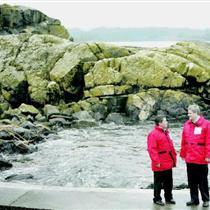 B.C. critical for Tory majority, Harper says Peter O’Neil, Vancouver Sun; Files from CanWest News Service Published: Saturday, January 20, 2007
B.C. critical for Tory majority, Harper says Peter O’Neil, Vancouver Sun; Files from CanWest News Service Published: Saturday, January 20, 2007
“OTTAWA — Prime Minister Stephen Harper, on Vancouver Island Friday to announce $1.5 billion for renewable energy initiatives, said B.C. is “critical” to his hopes of winning a majority government….” Harper was in Metchosin, near Victoria, to unveil an environmental incentive package in which the Conservatives will spend $1.5 billion over 10 years to boost Canada’s supply of wind, ocean, solar and other green energy. He said the package will boost the production of renewable energy by 4,000 megawatts a year. “In terms of greenhouse gas reductions, that’s the equivalent of taking one million cars off the road,” he said.
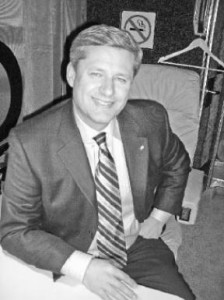 Putting ‘green’ toward going green Edward Hill, Peninsula News Review Jan 24 2007 Putting ‘green’ toward going green Edward Hill, Peninsula News Review Jan 24 2007….”Prime Minister Stephen Harper announced a $1.5 billion funding package for clean green energy generation Friday at Lester B. Pearson College in Metchosin, the host of North America’s first operational tidal turbine. Coined the ecoEnergy Renewable Initiative, $1.48 billion over 10 years has been earmarked toward helping industry harness renewable, zero or low emission energy sources, such as wind, solar, tidal, wave, biomass or small hydro………” |
||
| PM to Boost Funding for Tidal Power… trip to Metchosin will heighten new Tory support for alternate energy Peter O’Neil, and Richard Watts, Times Colonist; CanWest News Service Published: Friday, January 19, 2007
|
| Tories announce $1.5-billion renewable energy plan, CBCnews “Harper said a 10-year incentive program, the so-called ecoEnergy Renewable Initiative, will be established to fund eligible projects to be constructed over the next four years.”
|
Archived Videos : First Nations at Race Rocks
On November, 2003, we hosted a group of First Nations divers from Nass River. Matt Hill provided information on the marine resources of that area.
On May 2, 2000, we were privileged to take several members of local First Nations to Race Rocks. The late Earl Claxton, councillor of the Tsawout First Nations and his grandson were among those attending. Joe Bartleman, councillor of the Tsartlip First Nations also helped us to visualize the importance of marine animals in the diet of the people.
They talked with us about the past and present role of coastal ecosystems in the lives of the Salish people. These people always have been an integral part of ecosystems such as this one at Race Rocks. These video clips convey some of the stories that Earl and Joe had to tell about their people and their interactions with marine resources.
“When the tide went out, the table was set” for First Nations people in this area. At Race Rocks this would have been particularly important because of the rich biodiversity in the intertidal zone.
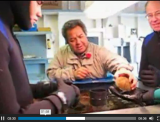 |
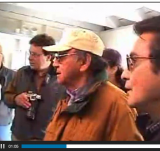 |
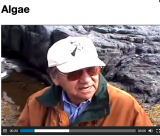 |
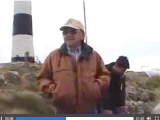 |
| Matt Hill explaining the Northern BC First Nations names of marine resources | Earl Claxton, councillor of the Tsawout First Nations and Joe Bartleman, councillor of the Tsartlip First Nations interviewed at Race Rocks offer comments on the role of First Nations people in the coastal ecosystem of the Salish Sea. | Earl tells us about the food and medicinal role of some marine algae from the intertidal areas | Transportation on the Salish Sea was so important to the cultures of the West Coast. While looking at an old carved canoe, Earl reflects on the types of canoes used . This canoe is used as a focal point for First Nations resources in our education program. |
The Salish First Nations have lived as part of the Race Rocks Ecosystem for millennia. We have been fortunate to have as our advisor on the Marine Protected Area Advisory Committee a long time friend of the Pearson College Community, Tom Sampson of the Tsartlip First Nation. Through his wise guidance, we have come to realize the importance of the Race Rocks area as a valuable resource for education about First Nations Values.
Archive of Scenes and Activities at Race Rocks
Canadian Geographic Kids Program
The CBC TV crew accompanied us on a dive to Race Rocks in order to video a sequence that later was used on the nationally televised Canadian Geographic Kids program.
- Alex Chan is interviewed by the show host.
- The CBC crew filming
- Chris Blondeau checks out the divers before descent
- The TV crew from Canadian Geographic Kids Program .


